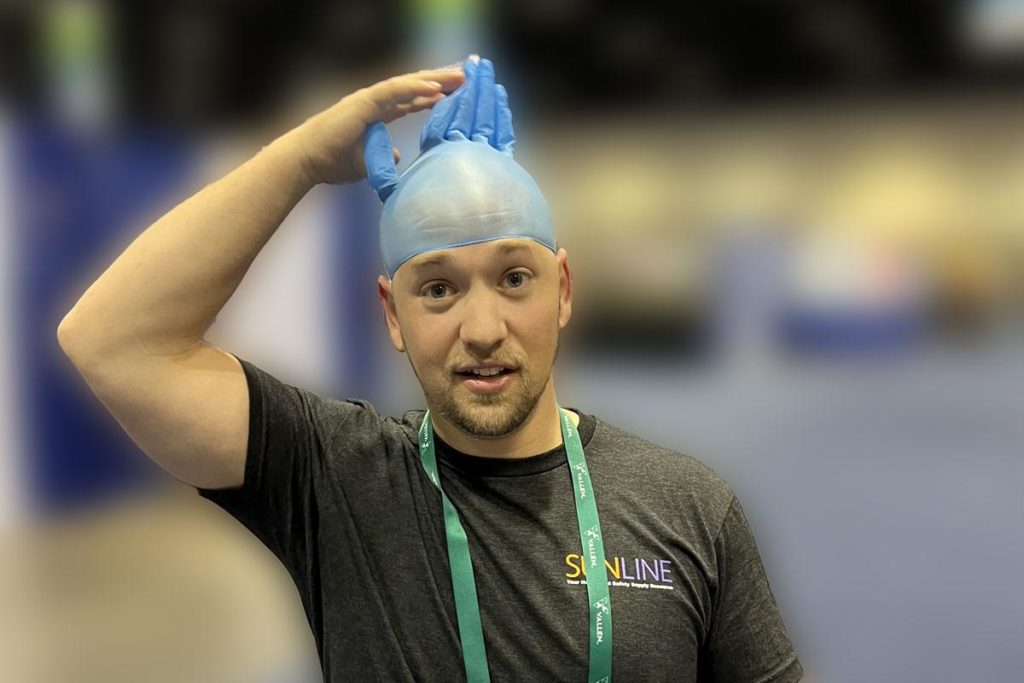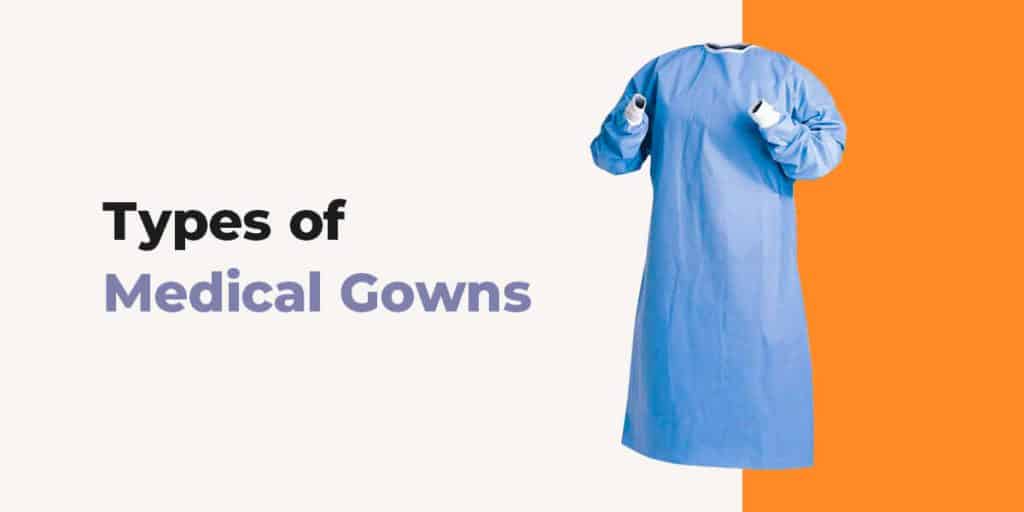
Types of Medical Gowns
From the operating room to the oil refinery, protective gowns are a crucial line of defense against various harmful or potentially harmful substances, like bodily fluids and chemicals. As with many items used in the healthcare sector, there are some crucial standards for hospital gowns and choices regarding appropriate use. The right type of gown can be the only thing between personnel and dangerous materials, so understanding their use is essential.
Let’s take a closer look at medical protective clothing, its manufacturing requirements and how to select the right one for your practice or facility.
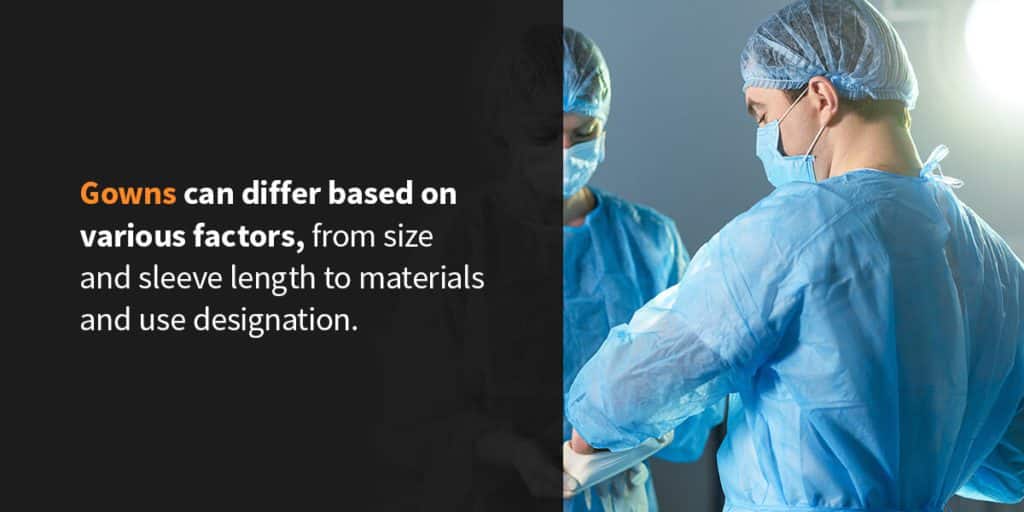
What Are Medical Gowns For?
Whether you call it an isolation gown, surgical gown, procedural gown or some other term, medical gowns provide a barrier against infectious materials and help protect the wearer from infection or illness. They safeguard patients and clinicians alike, offering infection control throughout different settings. Other places you might see them include industrial operations where hazardous chemicals are present, as they can provide a barrier between splashes and the wearer.
There are several different types of medical gowns and multiple levels of protection that must match the environment. Gowns can differ based on various factors, from size and sleeve length to materials and use designation. Some types of gowns go through a 510(k) process for premarket notification, in which they notify and prove to the FDA that the device is substantially equivalent to another device on the market.
Here are some different types of medical gowns.
- Surgical gowns: The FDA considers these gowns a Class II medical device, requiring premarket notification. They can cover all risk levels and protect patients and practitioners from the transfer of bodily fluids, microorganisms and particulate matter.
- Surgical isolation gowns: These gowns, used in medium- to high-risk settings, consist almost entirely of the most durable fabric — in other words, there are very few weak spots. They’re also a Class II medical device and must have premarket notification.
- Non-surgical gowns: As Class I devices, non-surgical gowns don’t require premarket review before going on the market. They are only for low- or minimal-risk situations, providing against microorganisms and body fluids. You may see them as gowns for visitors or worn during basic care.
Whatever situation they’re in, from industrial hazards to healthcare settings, these gowns are a type of personal protective equipment.
What Are the Standards for Medical Gowns?
As a medical device, PPE gowns must uphold high production standards set by the FDA, the Association of the Advancement of Medical Instrumentation and the American National Standards Institute. These standards are a crucial part of ensuring gowns and other forms of PPE are reliable and appropriate for medical or industrial use.
Specifically, these protective gowns must conform to ANSI/AAMI standard PB70, which outlines tests that validate a gown’s ability to offer the appropriate level of barrier protection. For instance, surgical gowns used for high-risk situations like surgery must pass blood and viral penetration tests, while gowns for lower-risk circumstances such as basic care may only need to pass tests for minimal water resistance.
Testing standards from the American Society for Testing and Materials also provide further information on surgical gown performance. The following tests address specific aspects of a medical gown’s design.
- Tear resistance: ASTM D5587 (nonwoven), ASTM D5587 (woven), ASTM D1424
- Tensile strength: ASTM D1682, ASTM D5034
- Lint generation: ISO 9073 Part 10
- Seam strength: ASTM D751 (knit or stretch woven)
- Water vapor transmission, or breathability: ASTM D737-75, ASTM D6701 (nonwoven), ASTM 51868 Part B
Gowns do not have standardized names, so it’s more helpful to look at the product’s specifications to understand its intended use and how you can expect it to perform.
Medical Gown Protection Levels
Medical gowns fall under one of four levels of protection, known as AAMI levels.
- Minimal risk: A Level 1 gown is for low-risk situations, such as basic care applications, cover gowns for visitors and standard medical unit use. It offers a slight barrier to block small amounts of fluid, as tested by putting water on the surface of the gown.
- Low risk: Level 2 gowns are for low-risk situations, such as working in a pathology lab, drawing blood from a vein or suturing a patient. They work on larger amounts of fluids from splattering and some exposure from soaking.
- Moderate risk: As the risk level rises, Level 3 gowns offer a barrier for even more fluid penetration from splatters and soaking. They’re appropriate for tasks like arterial blood draws, inserting IV lines and activities in the emergency room or trauma units.
- High risk: For the highest-risk situations, you’ll find protection from fluid and virus penetrations in a Level 4 gown. These gowns are suitable for lengthy, fluid-intense procedures, such as surgery, and situations requiring resistance to pathogens and non-airborne infectious diseases.
Knowing the difference between these levels is essential for PPE buyers. It offers an easy way to identify the protection offered by a gown. Typically, only Level 3 and 4 gowns are surgical gowns or surgical isolation gowns.
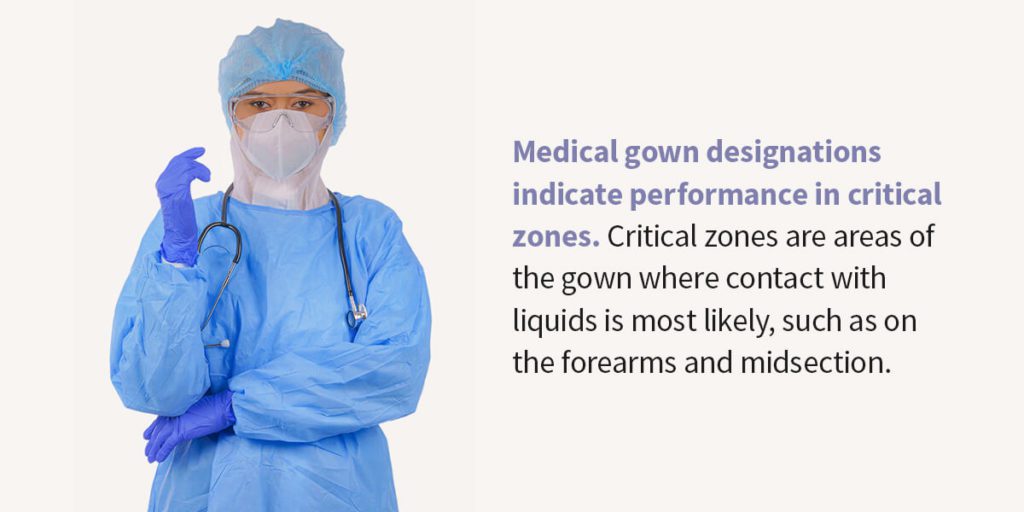
Testing Medical Gowns
With so many strict standards in place, it’s no surprise that a gown must undergo many different tests before sale. After all, a gown that can’t live up to its promises can create a severe health hazard.
Gowns intended for levels 1-3 are subject to impact penetration and hydrostatic pressure tests from the American Association of Textile Chemists and Colorists.
- Impact penetration: Impact penetration tests reflect a gown’s ability to resist fluid spatters. This test involves putting blotter paper behind the material, then spraying a specific volume of water onto it. Less water penetration equals better protection. Level 1 gowns must have results less than or equal to 4.5 grams, while Levels 2 and 3 must be less than or equal to 1 gram.
- Hydrostatic pressure: Hydrostatic pressure testing measures how well the material resists water penetration under contact with increasing pressure. As with impact penetration, less water moving through the material indicates better performance. Level 1 gowns do not undergo testing for hydrostatic performance, and Level 2 and 3 gowns must achieve results greater than or equal to 20 centimeters and 50 centimeters, respectively.
Both testing processes use water, but water has a much higher surface tension than blood. That means blood can penetrate through fabrics more easily. It’s critical to keep this in mind, because a fluid-resistant gown does not necessarily offer protection from blood.
For blood penetration and bloodborne pathogen tests, you’ll have to move up to the Level 4 gowns, which undergo testing against blood and viral penetration via ASTM standards F1670 and F1671. These standards use a virus, Phi-X174, which is similar in size to hepatitis C, hepatitis B and HIV, to measure penetration.
Medical gown designations indicate performance in critical zones. Critical zones are areas of the gown where contact with liquids is most likely, such as on the forearms and midsection. The zones offer the highest level of liquid barrier protection for the gown’s rating. Any non-critical zones must meet a minimum of Level 1 performance.
The critical zones of surgical gowns typically cover the forearms and the front portion of the gown from the shoulders down to the knees. Surgical isolation gowns and non-surgical gowns consist almost entirely of critical zones.
Clean vs. Sterile Medical Gowns
Gowns designated as sterile are the only ones appropriate for surgical use. These gowns have undergone specialized treatment during the manufacturing process and packaging that ensures they remain sterile until use. These qualities are essential for healthcare use and in many industrial workplaces, as they help create a contaminant-free environment and reduce the risk of foreign particles finding their way into a patient or sensitive work project.
These items must achieve a sterility assurance level of 10-6. The FDA recommends that manufacturers also provide details such as the sterilization method used, its validation process and the packaging used to maintain sterility. Depending on the approach used, the manufacturer may also supply other information, such as residual substances or radiation dosages.
What Are Washable or Reusable Isolation Gowns?
Disposable gowns offer easy cleanliness and safe disposal, but washable gowns have some benefits, too. They’re available for Level 1 and 2 gowns and provide a few advantages. They’re more affordable since you’re not paying for a new gown every time, and are often quite durable, providing exceptional performance even after many washes. And of course, you’re keeping more gowns out of the landfill and reducing the energy and water requirements used up by manufacturing methods.
While 80% of the isolation gown market belongs to disposable gowns, one study showed that reusable gowns continue to meet their rating specifications even after as many as 75 industrial washing cycles. They undergo testing against a variety of parameters, from seam strength to fabric thickness to pilling resistance.
If you’re not buying from trusted sellers, disposable gowns can also come with a little more risk — in times of outbreak, they’re easier to fake. Counterfeit gowns can have significant ramifications for healthcare and industrial professionals, so you must stay on top of the legitimacy of any gown purchases.
With either type of gown, you’ll still need to dispose of it when the gown becomes soiled or destroyed. For disposables, that’s typically after one use. With regular washing, washable medical gowns will usually last until physical deterioration occurs, which will vary from brand to brand but is often far in the future. Regularly inspect gowns before use for any tears, wearing or other signs of deterioration.
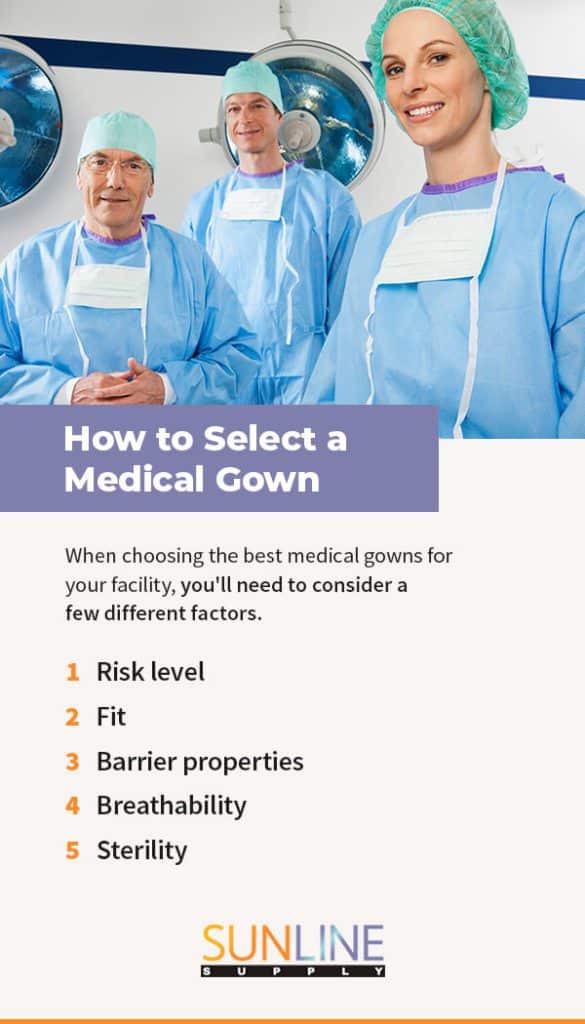
How to Select a Medical Gown
When choosing the best medical gowns for your facility, you’ll need to consider a few different factors.
- Risk level: Of course, the gowns you get will need to be appropriate for the task at hand. You cannot skimp on safety by choosing a lower protection level than called for. You’ll need to evaluate the dangers inherent in the task and whether the gown can adequately protect against them. See where your intended application falls on the list of AAMI levels and choose your gown from there.
- Fit: Ill-fitting PPE can be uncomfortable and risky, limiting the wearer’s freedom of movement and the ease at which they can respond to a rapidly changing situation. While comfort often comes second to safety, this level of flexibility is an essential part of the job in healthcare settings. Make sure staff have the proper sizes available to them. You may also want to consider other aspects of fit, such as how the gown closes and whether it has elastic cuffs. Elastic cuffs offer a better seal and go underneath gloves.
- Barrier properties: The various materials making up a gown will usually dictate how well it performs against fluid. If you anticipate fluid penetration, you’ll most likely need fluid-resistant gowns. Usually, this is easier to find in the spun synthetic material of washable gowns, rather than the cotton fabrics in disposable ones.
- Breathability: A more breathable medical gown provides greater comfort and freedom of movement to the wearers. Disposable gowns tend to be more breathable than reusable gowns, but this level can vary widely. Staff members enjoy the comfort, but it may be more important in some environments than others. For instance, if employees will be working in an outdoor vaccination clinic or a hot industrial shop floor, breathability can become a safety aspect.
- Sterility: Does the application call for a sterile gown or a clean one? Typically, a sterile gown is only necessary for invasive procedures. Still, sterile gowns can be beneficial in any situation where contamination could pose health risks or affect the quality of a product.
Remember, choosing the right PPE doesn’t mean much if your staff isn’t using it appropriately. Thoroughly train team members on how to select protective gowns and integrate them into your overall infection control program or standard operating procedures. Using gowns correctly is critical for keeping patients and staff safe throughout their workdays.
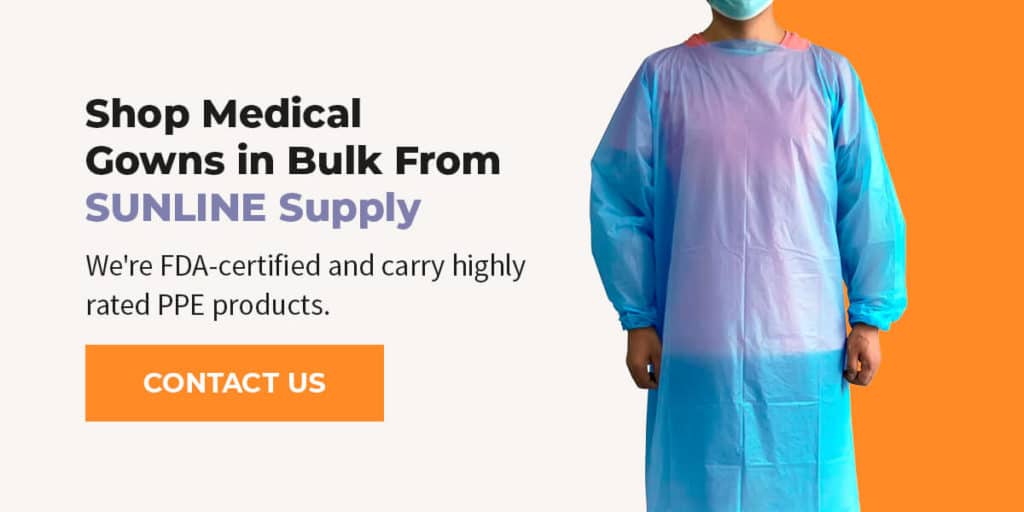
Shop Medical Gowns in Bulk From SUNLINE Supply
If your operation calls for bulk medical gown supplies, SUNLINE Supply can help. We only carry highly rated PPE products. Whether your work requires low-risk protection or barriers for high-risk tasks, we have a wide selection of gowns to choose from, both washable and disposable. Much of our stock is ready to ship out immediately, and you can buy bulk medical gowns online 24/7. Browse through our selection today.
Not sure what you need? Our friendly customer service team is happy to walk through your needs and help you find the right kind of gown for your team. Reach out to us to learn more!
